If you’re looking to add an exotic tropical vibe to your office or home, a ficus tree may be an excellent choice. Many types of ficus trees have glossy green leaves that make them beautiful for indoor and outdoor spaces.
My favorite ficus tree varieties are banana leaf fig, weeping fig, variegated rubber tree, retusa bonsai, and fiddle leaf fig. These varieties of ficus trees are easy to maintain and bring peace at home or office.
Choosing a ficus tree type that brings positive energy into your office or home may sound simple, but you’ll need to know a thing or two. This article explains how to identify ficus trees and their varieties. Let us dive into it:
How to Identify Ficus Trees (Identification Guide)
Ficus trees are ideal for indoor or outdoor spaces since they can tolerate different climatic conditions and environments. These trees represent good luck, a new beginning, and fertility.
Most ficus trees also bring peace and calmness to those people having them in their homes or offices. But identifying different types of ficus trees can be a daunting experience for beginners.
Here are quick tips for identifying ficus trees for your home or office:
Leaves
The leaves on a ficus tree are large, feathery, glossy, and dark green. These leaves grow in a rosette form and have distinctive veining patterns.
Bark
A ficus tree has smooth and brown bark with stout and sturdy branches. But the indoor ficus trees have less sturdy branches than their outdoor counterparts.
Fruits
Most varieties of ficus trees produce small and fleshy fruits that grow in clusters. These fruits are edible and have a sweet taste.
Different Types of Ficus Trees with Pictures
There are over 850 species of plants in the ficus genus. (Source: Oregon State University). It comprises woody trees, vines, shrubs, and plants that belong to the Moraceae family. Here is a list of ficus trees with pictures for your indoor or outdoor spaces:
Weeping Fig (Ficus Benjamin)
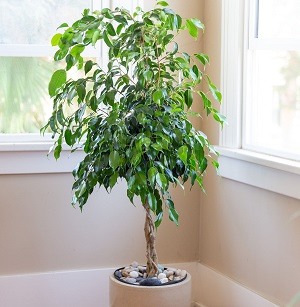
It is a popular ficus species ideal for growing in your indoor space. The shiny green leaves and bushy appearance help create an exotic tropical forest vibe in your space. Many houseplant enthusiasts refer to it as ficus benjamin.
Weeping figs have small leaves that grow in a cluster for decoration purposes. The thin flexible stems can be braided to suit the owners’ tastes and preferences. It also comes in numerous cultivars that can suit indoor and outdoor spaces.
The ease of care and maintenance is my favorite thing about weeping figs. We recommend providing bright indirect sunlight and moderate soil moisture to enhance healthy growth. Be sure to keep your ficus plant away from drafts to avoid stressing it.
| Suitable for Indoor/Outdoor | Both indoor and outdoor |
| Light Requirements | Bright indirect sunlight |
| Temperature and Humidity | 60-85oF and 40-65% |
| Watering Needs | Moderate soil moisture. Water 2-3 times a week during the spring and summer. |
| Maximum Growth | 3-6ft |
| Toxicity | Toxic to humans and animals |
Fiddle Leaf Fig (Ficus Lyrata)
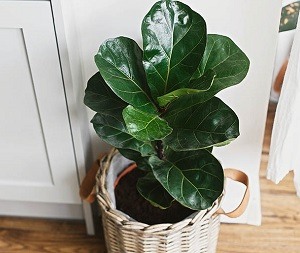
It is another popular indoor ficus tree with large green leaves that bring tropical forest vibes to your home or office. Many plant stores usually refer to it as ficus lyrata for easy identification by beginners and other season houseplant enthusiasts.
This slow-growing ornamental ficus tree can reach 9.8ft indoors and 50ft outdoors. The bushy appearance with deep green violin-shaped leaves alleviates its hustle of identification. Growing and caring for this ficus tree type can be challenging since it is fussy.
We recommend the provision of bright indirect sunlight and a moderate watering routine during the warm months. The ficus tree is also sensitive to abrupt environmental changes and is best to keep it away from drafty areas.
| Suitable for Indoor/Outdoor | Both indoor and outdoor |
| Light Requirements | Bright indirect sunlight |
| Temperature and Humidity | 60-80oF and 30-65% |
| Watering Needs | Moderate watering during the warm months. |
| Maximum Growth | 9.8ft indoors and 50ft outdoors |
| Toxicity | Mild poisonous to humans and animals |
Sandpaper Fig (Ficus coronata)

Sandpaper figs are native to Australia and have rough or sandpapery texture on their foliages. It is a large evergreen tree that can grow up to 115ft with a dense canopy. Many plant stores refer to sandpaper fig trees as ficus coronata.
The large dark green leaves cover the trunk and branches to form a slightly wavy edge. The leaf underside is pale green with tiny hairs. This ficus tree also produces small yellowish-green flowers that grow in clusters along the trunk and branches.
The attractive foliages and dense canopies make sandpaper figs ideal for backyard gardens or parks. The ficus tree type can also be found in the woodlands, rainforests, and coastal forests of Queensland and New South Wales.
| Suitable for Indoor/Outdoor | Outdoor |
| Light Requirements | Full sun |
| Temperature and Humidity | 65-85oF and high humidity |
| Watering Needs | Moderate to high |
| Maximum Growth | 115ft |
| Toxicity | Non-toxic to animals |
Sycamore Fig (Ficus sycamores)
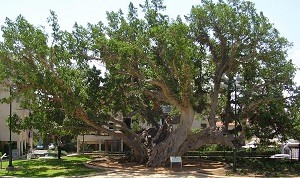
It is a large deciduous tree that can reach 115ft tall outdoors. The ficus tree species hail from Africa, the Middle East, and Australia. It is also an invasive species not idle for planting near the house or building structures.
Sycamore fig trees have round leaves that resemble sycamore trees. These ficus trees are also miniature versions of banyan trees. The ficus identification by leaf is the prominent method for spotting sycamore figs.
| Suitable for Indoor/Outdoor | Outdoor |
| Light Requirements | Full sun |
| Temperature and Humidity | 65-80oF and high humidity |
| Watering Needs | Moderate to high |
| Maximum Growth | 115ft |
| Toxicity | Poisonous to animals and humans |
Ficus Audrey (Ficus benghalensis)
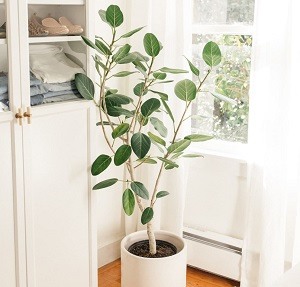
These are types of ficus trees indoors with luscious dark green velvety leaves and prominent cream-colored veins. Outdoor ficus Audrey trees are larger than their indoor counterparts with compact design.
Indoor ficus Audrey trees should be placed in an area with bright indirect sunlight and high humidity to foster healthy growth. Prolonged exposure to direct sunlight will scorch the leaves and dehydrate the plant.
| Suitable for Indoor/Outdoor | Both indoor and outdoor |
| Light Requirements | Bright indirect sunlight |
| Temperature and Humidity | 60-85oF and high humidity |
| Watering Needs | Moderate soil moisture. Water the tree every week during the warm months. |
| Maximum Growth | 10ft |
| Toxicity | Toxic to pets and humans |
African Fig Tree (Ficus cyathistipula)
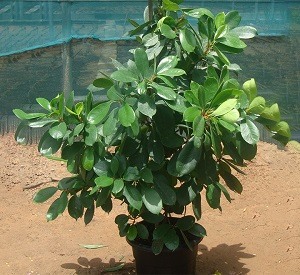
African fig trees are native to Africa and can grow up to 115ft tall. These large evergreen trees have glossy and oblong-shaped leaves. The tree produces small red fruits that are eaten by monkeys and other wild animals.
The ficus tree is ideal for landscaping in Africa and Australia. The leaves are used in making tea due to their medicinal content and thick bark can make fibers used in the textile industries. It is also a sacred tree among Swazi people in Africa.
The African fig tree is a symbol of strength and fertility. If you’re looking to add positive energy to your garden, the African fig tree is a perfect choice. It requires minimal maintenance and care routine than its counterparts.
| Suitable for Indoor/Outdoor | Outdoor |
| Light Requirements | Full sun |
| Temperature and Humidity | 60-85oF and high humidity |
| Watering Needs | High soil moisture |
| Maximum Growth | 115ft |
| Toxicity | Poisonous to animals and humans |
Variegated Rubber Fig (Ficus elastica)
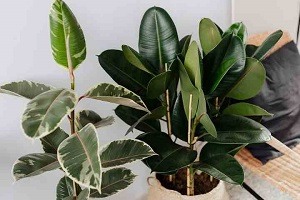
It is a cultivar of a burgundy rubber tree and has deep purple leaves with burgundy stems. It is an excellent choice for indoor space since it marks a bold statement. The rubber tree is native to tropical regions of Asia.
Variegated rubber figs are fast-growing and can reach 6ft tall. Outdoor rubber trees can reach up to 50ft tall in their natural habitat. The cultivar was developed in Europe and makes a great addition to your indoor plants.
| Suitable for Indoor/Outdoor | Indoor |
| Light Requirements | Bright indirect sunlight |
| Temperature and Humidity | 60-70oF and high humidity |
| Watering Needs | Moderate soil moisture that never gets soggy. |
| Maximum Growth | 6ft tall indoor |
| Toxicity | Poisonous to pets and humans |
Banana leaf fig (Ficus maclellandii)
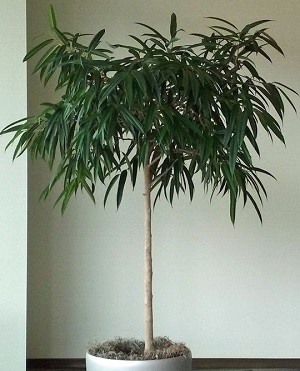
It is a tropical evergreen tree that hails from Indonesia, Malaysia, and Thailand. An outdoor banana leaf fig can reach up to 98ft tall with large leathery leaves. The trunk has a thick layer of brown-gray bark with branches that grow outwards.
The ficus tree produces small yellowish-green flowers that grow in clusters. The flowers turn into yellow or red fruits when they are ripe. The fruits are eaten fresh or made into preservatives, while the wood is for making furniture and other products.
| Suitable for Indoor/Outdoor | Outdoor |
| Light Requirements | Full sun |
| Temperature and Humidity | 60-80oF and high humidity |
| Watering Needs | Moderate soil moisture |
| Maximum Growth | 98ft tall |
| Toxicity | Poisonous to animals and humans |
Clown Fig (Ficus aspera parcelli)
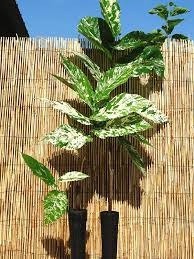
It is a type of ficus tree native to Malaysia and the large white flowers on the tree are the reason for the name clown fig. The clown fig is a rare ficus tree species since it is challenging to grow in nurseries or gardens.
Clown figs require full sunlight and water to thrive well. We recommend applying fertilizer during the spring and summer to promote a bushy appearance. A mature clown fig can reach up to 30ft tall and require a specific environmental condition to flourish.
| Suitable for Indoor/Outdoor | Outdoor |
| Light Requirements | Full sun |
| Temperature and Humidity | 75-80oF |
| Watering Needs | Moderate soil moisture |
| Maximum Growth | 30ft tall |
| Toxicity | Poisonous to pets and humans |
Common Fig (Ficus carica)
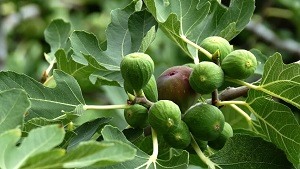
It is a deciduous ficus tree that can reach up to 30ft tall with large, lobed, and leathery texture foliages. The ficus tree produces oblong-shaped fruits with greenish-yellow and pink hues. The fruit flesh can be pink or red with small black seeds.
Common figs are native to Mediterranean regions and their fruits are ingredients for popular dishes. The leaves are used for decoration or as wrapping materials for many centuries. These fig trees are ideal for parks or large gardens.
| Suitable for Indoor/Outdoor | Outdoor |
| Light Requirements | Full sun |
| Temperature and Humidity | 65-85oF and high humidity |
| Watering Needs | Moderate soil moisture |
| Maximum Growth | 30ft tall |
| Toxicity | Non-poisonous to animals and humans |
Council Tree (Ficus altissima)
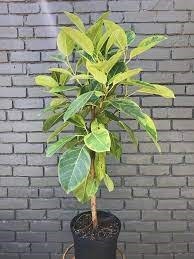
It is another type of ficus tree native to tropical regions. The leaves arrangement on the branches is the reason for the name since they resemble a council meeting. This evergreen tree can reach 98ft tall in its natural habitat.
The trunk is straight with smooth bark of gray or brown color. The larger leaves have a deep green color with a leathery texture and produce small white flowers that grow in clusters. The fruits are small and red.
| Suitable for Indoor/Outdoor | Outdoor |
| Light Requirements | Full sun |
| Temperature and Humidity | 65-85oF and high humidity |
| Watering Needs | Moderate moist soil |
| Maximum Growth | 98ft |
| Toxicity | Poisonous to pets and humans |
Ficus Daniella (Ficus Moclame)
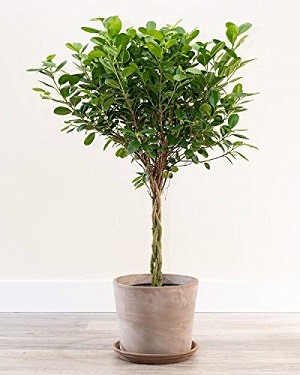
It is an indoor ficus tree with thick waxy oval-shaped leaves. Ficus Daniella hails from Brazil and other parts of South America. This ficus tree has been introduced to Africa and Asia due to its ability to tolerate different climates.
A mature Daniella tree can reach up to 20ft tall with glossy dark green leaves. This plant also produces small white blooms under bright indirect sunlight. You can propagate ficus Daniella via seeds and cuttings.
| Suitable for Indoor/Outdoor | Both indoor and outdoor |
| Light Requirements | Bright indirect sunlight |
| Temperature and Humidity | 60-80oF and high humidity |
| Watering Needs | Moderate moist soil |
| Maximum Growth | 20ft tall |
| Toxicity | Toxic to pets |
Indian Banyan (Ficus benghalensis)
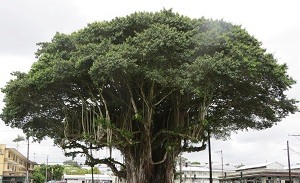
It is a large evergreen tree with a dense canopy of dark green leaves and woody branches. The Indian banyan can reach up to 98ft tall in its natural habitat. The ficus tree hails from India, Sri Lanka, Pakistan, and Bangladesh.
The Indian banyan is a sacred Hindu tree grown near temples and other religious sites. The leaves have medicinal properties making the tree popular in many backyard gardens. It is also an excellent alternative to the bonsai tree.
| Suitable for Indoor/Outdoor | Outdoor |
| Light Requirements | Full sun |
| Temperature and Humidity | 60-85oF and high humidity |
| Watering Needs | Moderate soil moisture |
| Maximum Growth | 98ft tall |
| Toxicity | Toxic to pets |
Indian Laurel (Ficus microcarpa)
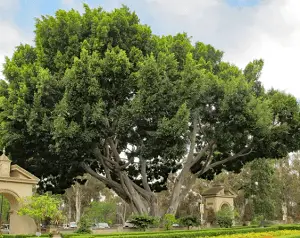
It is an evergreen fig tree species that hails from India and other Asian regions. The tree can reach 98ft tall with a spread of 65ft wide. The leaves are green all year round and help to mark a bold statement in the garden or parks.
Juvenile leaves are dark green and covered in small reddish-brown buds. The tiny yellow flowers appear during the spring and summer. The small red figs are fruits that ripen in the summer for wild animal consumption.
| Suitable for Indoor/Outdoor | Outdoor |
| Light Requirements | Full sun |
| Temperature and Humidity | 65-80oF and high humidity |
| Watering Needs | Moderate soil moisture |
| Maximum Growth | 98ft tall |
| Toxicity | Toxic to humans and animals |
Long Leaf Ficus (Ficus binnendijkii)
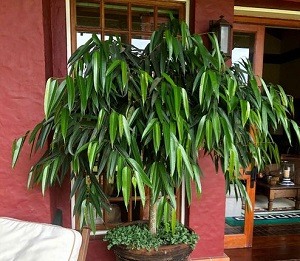
It is a type of ficus tree native to Southeast Asia with a maximum height of 30ft. The large dark green leaves and small greenish-yellow figs are the reason for the longleaf ficus’s popularity in many homes or parks.
The large canopy and stunning appearances make long leaf figs a perfect choice for shade trees or ornamental trees. This fast-growing ficus tree is an excellent alternative to bonsai trees since the shape and size can be controlled.
| Suitable for Indoor/Outdoor | Outdoor |
| Light Requirements | Full sun |
| Temperature and Humidity | 65-85oF and high humidity |
| Watering Needs | Moderate soil moisture |
| Maximum Growth | 30ft tall |
| Toxicity | Toxic to pets |
Mistletoe Fig (Ficus deltoidea)
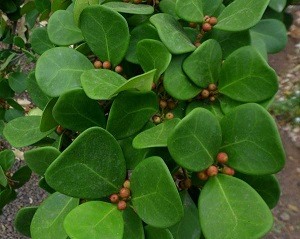
Mistletoe fig trees are native to Southeast Asia (India, Sri Lanka, Malaysia, Indonesia, and the Philippines). The ficus tree is also known as the Curtain fig tree in Australia. It has simple leaves with leathery texture and smooth margins.
The fig tree can reach up to 98ft tall and requires adequate space to thrive. The leaves have medicinal properties ideal for treating diarrhea, dysentery, and other gastrointestinal disorders among humans.
| Suitable for Indoor/Outdoor | Outdoor |
| Light Requirements | Full sun |
| Temperature and Humidity | 65-85oF and high humidity |
| Watering Needs | Moderate soil moisture |
| Maximum Growth | 98ft |
| Toxicity | Poisonous to pets |
Moreton Bay Fig (Ficus macrophylla)
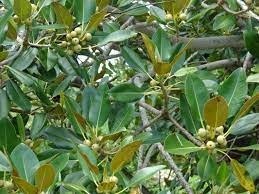
It is a large evergreen tree among various ficus microcarpa varieties. The ficus tree derives its name from Moreton Bay in Queensland Australia. It can grow up to 197ft tall in its natural habitat.
The massive trunk and dense canopy make the Moreton bay fig tree ideal for landscaping. It provides excellent shade and shelter in the parks and gardens. Many film enthusiasts in Australia prefer using the tree in making documentaries.
| Suitable for Indoor/Outdoor | Outdoor |
| Light Requirements | Full sun |
| Temperature and Humidity | 65-85oF and high humidity |
| Watering Needs | Moderate soil moisture |
| Maximum Growth | 197ft tall |
| Toxicity | Toxic to pets |
Narrow Leaf fig (Ficus maclellandii ‘Alii’)
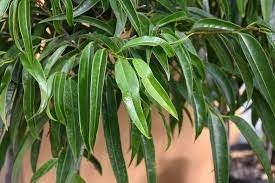
It is a type of ficus tree that grow indoors without any challenges. This evergreen fig tree has long stems and leaves to create a bushy appearance in the house. The long drooping leaves will mark a bold statement in your indoor space.
Narrow-leaf figs can reach up to 10ft tall and more. We recommend pruning the fig tree yearly to control its height and size. The plant thrives under bright indirect sunlight and moist soil that never gets soggy.
| Suitable for Indoor/Outdoor | Indoor |
| Light Requirements | Bright indirect sunlight |
| Temperature and Humidity | 60-75oF and high humidity |
| Watering Needs | Moist soil that never gets soggy |
| Maximum Growth | 10ft tall |
| Toxicity | Toxic to pets and humans |
Red Leaf Fig (Ficus congesta)
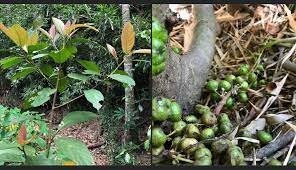
It is a tropical tree native to the South American, African, and Southeast Asian rainforests. It grows up to 100ft tall in its natural habitat with glossy dark green foliages. The red or purple hues on the leaves help create a bold statement.
The fig tree also produces small yellow-green flowers that turn into red or purple fruits. These fruits provide food for monkeys, birds, and bats. Indigenous people of Africa and South America use the fig tree in their traditional medicine.
| Suitable for Indoor/Outdoor | Outdoor |
| Light Requirements | Full sun |
| Temperature and Humidity | 60-85oF and high humidity |
| Watering Needs | Moderate moist soil |
| Maximum Growth | 100ft tall |
| Toxicity | Non-toxic to animals and humans |
Retusa Bonsai (Ficus retusa)
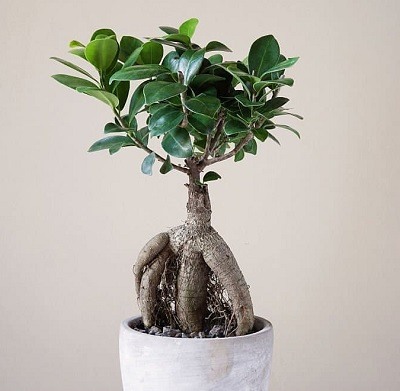
It is a tropical tree native to Southeast Asia and a member of ficus microcarpa varieties. It experiences a compact growth habit and produces small dark green leaves. The tree also produces small white flowers that turn into yellow-orange fruits.
The ease of care and maintenance make retusa bonsai beginner-friendly. It can be grown indoors and outdoors due to its tolerance to various conditions. It can tolerate some drought conditions without ruining its appearance.
| Suitable for Indoor/Outdoor | Indoor and outdoor |
| Light Requirements | Full sun or partial shade |
| Temperature and Humidity | 60-80oF and high humidity |
| Watering Needs | Moist soil that never gets soggy |
| Maximum Growth | 3ft tall |
| Toxicity | Poisonous to humans |
People Who Read This Also Read: